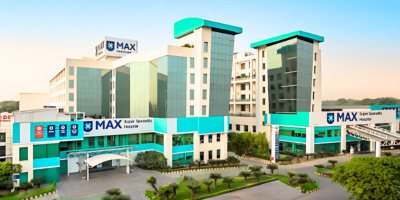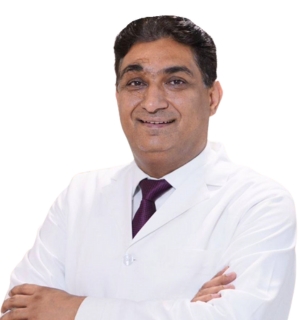Low-cost Anterior Cervical Discectomy Fusion (ACDF) in New Delhi India: Complete Guide

Get Anterior Cervical Discectomy Fusion (ACDF) in New Delhi, India, at low costs.
Know all about the surgical procedure, risks, complications and recovery right here.
Connect with us
What Is the Cost of Anterior Cervical Discectomy Fusion (ACDF) in New Delhi, India?
The cost of an Anterior Cervical Discectomy Fusion in New Delhi, India, is approximately $5,200. On the other hand, the cost of the same procedure in the United States can range between $11,000 to $25,000[1].
However, the exact cost depends on:
- Difficulty of the procedure
- Pre-existing condition
- Surgeon, hospital admission and medical expenses
Connect with us to know details on what's included and what's not in the cost packages.
Here is a cost comparison of Anterior Cervical Discectomy Fusion in India Vs the US:
| Treatment | Cost in India (USD) | Cost in the US (USD) |
| Anterior Cervical Discectomy Fusion | $5200 | $11,000-$25,000 |
Cost of Alternative Spine Surgeries
Let's look at some alternative spine surgeries apart from ACDF. Here is a cost comparison table showing the costs of each procedure in India and the US
|
Treatment Type |
Cost in India (USD) |
Cost in the US (USD) |
| Lumbar Discectomy | $4200 - $5500 | $15,000 to $35,000[2] |
| Spinal Fusion | $5500 | $80,000 – $150,000[3] |
| Lumbar Disc Replacement with Implants | $4700 | $30,000 onwards[4] |
| Endoscopic discectomy | $3500 to $6000 onwards | $15,000-$50,000[5] |
| Minimally Invasive Spine Surgery | $5500 | $87,000 onwards[6] |
| Laminectomy | $8600 | $50,000 to $90,000[7] |
Alternative spine surgeries are performed based on the patient's requirements and disease considerations:
- Lumbar Discectomy surgery: Removes a damaged disc in the lower back that's pressing on a nerve and causing pain. Read all about how to get a Lumbar Discectomy in New Delhi, India.
- Spinal Fusion: Surgery that permanently connects two or more vertebrae in the spine to stop movement between them. This reduces pain and stabilizes the spine.
- Lumbar Disc Replacement Surgery: Here, a damaged disc in the lower back is replaced using titanium cervical disc replacement.
- Endoscopic discectomy: Uses a thin tube with a camera and light for the surgery. This is a minimally invasive surgical procedure.
- Minimally Invasive Spine Surgery: Uses smaller incisions than standard surgery. This often causes less harm to nearby muscles and tissues. Leads to less pain and faster recovery.
- Laminectomy: This type of surgery in which a part or all of the vertebral bone is removed.
Procedure: Anterior Cervical Discectomy Fusion (ACDF) in New Delhi, India
Anterior Cervical Discectomy Fusion (ACDF) in New Delhi, India is a surgical procedure done to treat cervical disc herniation and nerve compression.
ACDF is done by an orthopaedic surgeon or neurosurgeon under general anaesthesia. To avoid sensitive structures, the spine is accessed through the front of the neck.
The herniated disc is removed, and a graft material (from your pelvic bone, a bone bank, or synthetic material) is used to fuse the vertebrae to hold them together with screws for stability. The incisions are then stitched.
- Degenerative Disc Disease
- Cervical Deformity
- Craniovertebral junction abnormalities
- Prolapse of intervertebral disc
- Cervical Compressive Myelopathy
How can International Patients Get ACDF?
First Touch Point:
- MTC medical advisors reach out to patients who have spine issues and check their already existing reports.
- Initial medical reports are examined, including spine scans, X-rays, MRI, CT, Electromyogram (EMG), and Nerve Conduction Studies (NCS), if any.
- Physical examination reports are also assessed for reflexes, muscle strength, range of motion, sensitivity to touch, walking ability, and tender regions in the back.
- Our medical advisors discuss with partner hospitals whether ACDF is required.
- Surgery is usually the last resort for a spine issue. Many times with medication and physiotherapy, herniations and other disorders can be managed.
- If the reports dictate that surgery is required, the treatment plan is chalked out.
- Video calls take place with orthopaedic experts and patients to discuss the procedure in detail.
The patient travels to New Delhi for an ACDF.
Before the Surgery
- Once the patient visits the partner hospitals, 1-2 days of investigation are done thoroughly.
- New imaging, radiology examination, or clinical examination could be needed.
- Neurology experts may intervene. Once the magnitude and intensity are decided, the ACDF is scheduled.
Here is a timeline of the surgery
| Phase | Duration |
| Pre-operative | 1- 2 days |
| Surgery | 2-4 hours |
| Post-operative recovery | 6- 8 weeks for complete recover |
Recovery after ACDF Procedure
- After surgery, you'll be closely monitored for hours to days, depending on the surgery's complexity and your health.
- Discharge typically occurs within two days once stable. You’ll receive training to move without straining your neck.
- Full recovery takes 6-8 weeks, requiring constant cervical support.
- Follow your doctor’s advice on diet, medication, and warning signs.
Risks and Complications of ACDF
- Incision site infection may require systemic antibiotics
- Hypersensitivity to anesthesia and other drugs
- Bleeding at the surgical site
- Damage to nearby organs, tissues, or nerves, causing pain or loss of sensitivity
- Difficulty in swallowing for a few days post-surgery
- Possible speech difficulties due to vocal cord damage
- Recurrence of symptoms from cervical spine weakness or instability
- Pseudarthrosis (incomplete bone fusion) in individuals with diabetes, tobacco use, smoking, or advanced age
Benefits of ACDF Procedure
- Spine Realignment: ACDF helps realign the spine, creating space for nerve roots and stabilizing damaged areas
- Pressure Relief: The procedure lightens pressure on the spinal cord and nerves, reducing neural compression, pain, and arm pain in cervical radiculopathy
- Arthritis Management: ACDF can effectively manage certain types of arthritis that cause neck pain
- Malalignment Correction: The surgery corrects congenital malalignment of the cervical spine
- Fracture Treatment: ACDF is used to treat fractures in the vertebrae extending from C4 C5 C6 C7 neck region
Overview of ACDF
Anterior Cervical Discectomy and Fusion (ACDF) or anterior cervical decompression is a surgical procedure used to solve problems in the neck region.
It reduces pain and gives stability to patients suffering from conditions such as herniated discs, spinal stenosis, or degenerative disc disease.
What Is Anterior Cervical Discectomy Fusion?
The lumbar and cervical spines are important parts of the back and neck. They help you move and stay flexible. Problems like herniated discs, arthritis, and fractures can cause pain and make movement difficult.
Anterior Cervical Discectomy Fusion (ACDF) surgery relieves pressure on the spinal cord and nerves, fixes the spine's alignment, and makes the spine more stable.
Global estimates suggest that close to 313 million[8] spine surgeries are performed annually, with herniated discs being the most common cause of undergoing spine surgery.
Spine Health and Surgery
Doctors and researchers underline stress, lifestyle, and age as major factors, with neuromuscular disorders, genetics, and psychological disturbances as added factors to the increase in spine issues.[9]
While spine health issues are on the rise globally, India is a hub for spine health care to international patients due to its affordable, quality treatments, all while offering significantly lower costs compared to the US.
What Is the Success Rate for Anterior Cervical Discectomy Fusion in India?
The success rate of Anterior Cervical Discectomy Fusion in India is up to 90%[10].
Early diagnosis, the skill of orthopedics and neurosurgeons, and the execution of a thorough treatment plan for a trouble-free recovery are all factors in this accomplishment.
Best Hospital for Anterior Cervical Discectomy Fusion in New Delhi India

JCI-accredited, it is one of the largest private hospital. It ranks among the top 10 multi-specialty hospitals.
Dedicated services for medical tourists from over 100+ countries.
It serves local and international patients, specializing in orthopedic treatments, cancer, bariatric surgery, and cardiology with advanced, European-standard equipment.
- 60+ Years of Experience
- JCI Accredited
- NABH Accredited

NABH-accredited, this hospital is a renowned 250-bed hospital in New Delhi.
The hospital is well-equipped with Tesla MRI and Cath Labs and 50+ critical beds. With this, it offers Orthopaedics, Cardiology, Urology, Neurology, Paediatrics, Obstetrics, and Gynaecology.
- NABH Accredited
- 300+ Doctors
- 22+ Departments
Best Surgeon for Anterior Cervical Discectomy Fusion in New Delhi India

Dr. Puneet Girdhar( BLK-Max Super Speciality Hospital )
Dr. Girdhar has fellowships in spine surgery (Wales), arthroplasty (Germany), and trauma (USA). He has performed 10,000+ surgeries, including robotic spine procedures.
He leads the Orthopedic Spine Surgery department at BLK-Max Institute.
Memberships
- North American Association of Spine Surgery
- European Spine Society
- AO Spine International
Why MTC Partners for Anterior Cervical Discectomy Fusion in New Delhi
- Expert leadership: MTC Partner hospitals work with spine and orthopedic surgeons with over 3 decades of experience.
- Advanced technology: We use minimally invasive techniques such as endoscopic and robotic ACDF surgeries. This includes PEEK, 3D-printed, hybrid, and interbody implants.
- Comprehensive support: Our partners offer customized holistic care. Our specialists collaborate to develop a personalized treatment plan that incorporates advanced diagnostic tests and supportive therapies.
Conclusion
Anterior Cervical Discectomy Fusion in New Delhi, India, offers a high success rate of up to 90%, speedy recovery, and cost-effective options. These are just a few of the many benefits of choosing spine surgery from the best surgical programs in India.
Is ACDF in New Delhi, India Safe?
- Yes, Anterior Cervical Discectomy Fusion in New Delhi, India, is safe. Research has shown that Indian hospitals meet global healthcare standards. They have skilled surgeons with a high success rate.
- India has a long history of successful spine surgeries[11], with decades of positive outcomes and satisfied patients. Additionally, the country's medical facilities are equipped with the latest technology, making it a prime destination for spine surgery.
FAQs
Permanent restrictions after ACDF surgery include avoiding high-impact activities, body contact sports, heavy lifting, and limiting extreme neck movements. The fusion part limits the movement and free mobility of the neck. However, these restrictions vary based on individual recovery and the surgeon's advice.
Walking is the safest and best exercise after ACDF surgery. Other exercises include simple neck movements such as flexion, extension, rotation, and diagonal neck stretching. Shoulder shrugs, jaw lowering, and diaphragmatic breathing.
Sleep in a neutral position to reduce pressure on the surgical site. In the first few weeks, sleeping on your back with a supportive pillow under your neck and head is ideal. You may also sleep on your side with a pillow between your knees. If prescribed, wear your collar while sleeping for the first 2–6 weeks.
References
- Walter Kluwers: Big differences in U.S. healthcare costs for fixing back pain
- Becker's spine review: Average cost of the 4 most common spine surgeries
- Barricaid: What Will I Pay for a Microdiscectomy if I Don’t Have Insurance?
- Healthline: What Minimally Invasive Spine Surgery Is and How It Works
- Frontiers: Transforming Standard of Care for Spine Surgery: Integration of an Online Single-Session Behavioral Pain Management Class for Perioperative Optimization
- BMC Musculoskeletal disorders: Neck pain: global epidemiology, trends and risk factors
- Journal of Craniovertebral junction and spine: A systematic review of risk factors and adverse outcomes associated with anterior cervical discectomy and fusion surgery over the past decade
- Journal of Clinical Orthopaedics and Trauma: India contribution to Spine Surgery: 15 most influential articles



